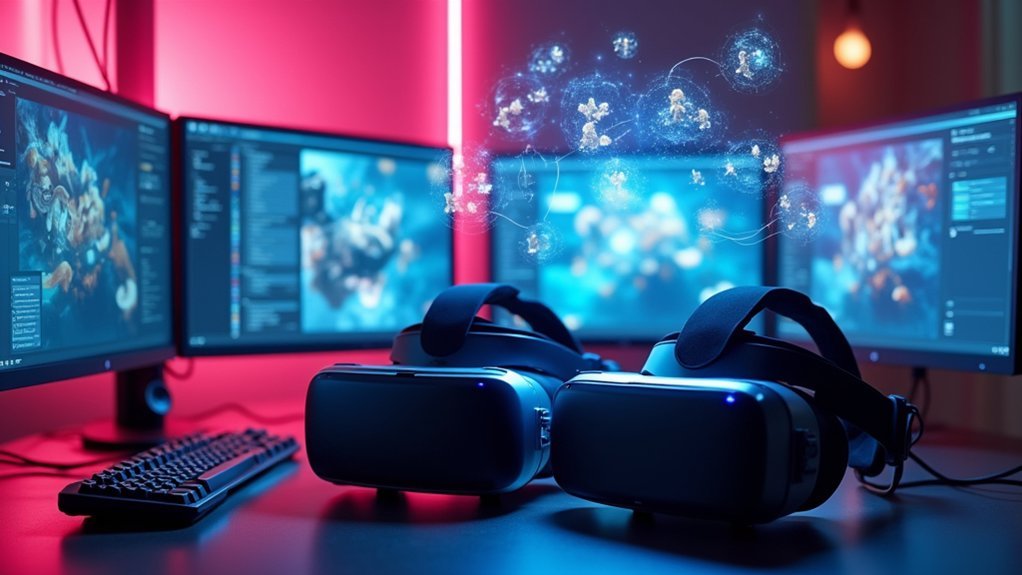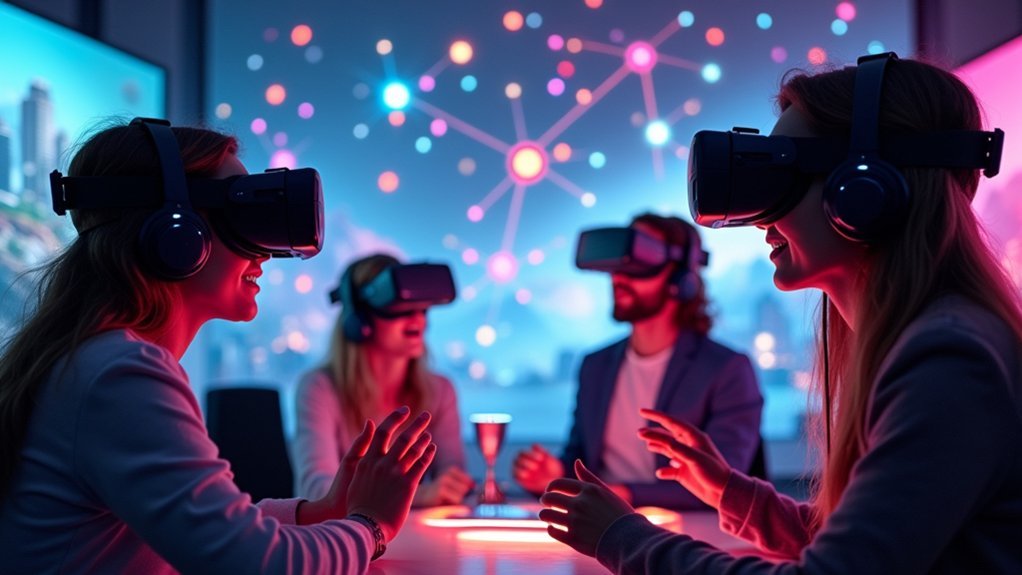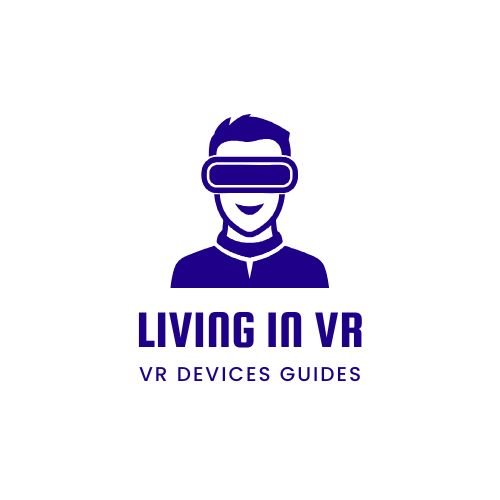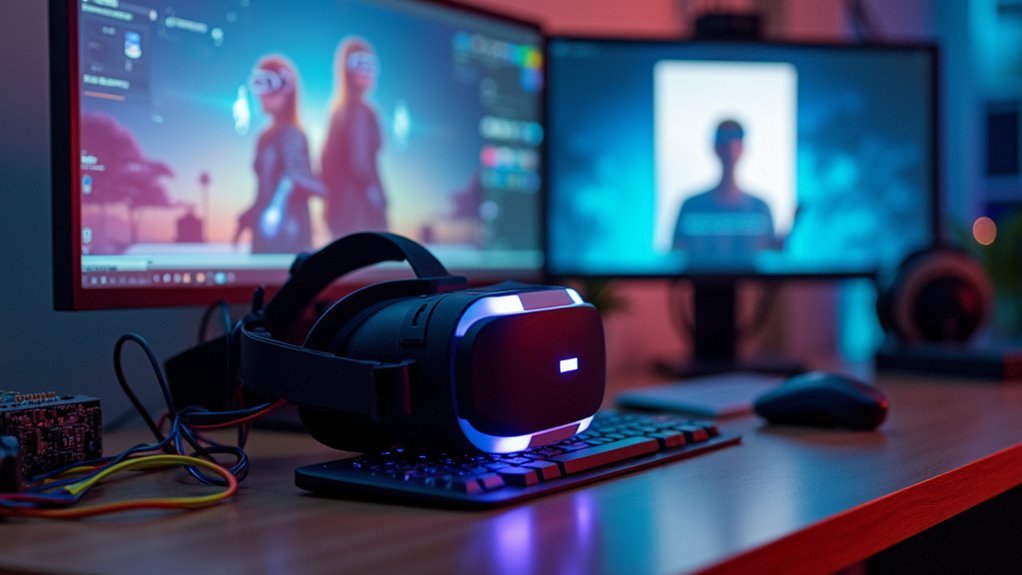You’ll need Unity Netcode for GameObjects as your high-level networking foundation, paired with XR Interaction Toolkit for essential VR interactions. VR Interaction Framework accelerates development with pre-built components, while Photon Unity Networking offers seamless room-based multiplayer setup. Unity Cloud Multiplayer Services handles infrastructure automatically, and XR Device Simulator lets you test without physical hardware. Network Manager Components serve as your central control hub for connections. Mastering these seven tools will transform your VR multiplayer development approach entirely.
Unity Netcode for GameObjects

Unity Netcode for GameObjects (NGO) serves as a high-level networking framework that streamlines multiplayer VR development by handling the complex networking infrastructure behind the scenes.
You’ll benefit from built-in support for networked objects, automatic synchronization, and remote procedure calls that eliminate manual coding overhead.
NGO’s network variables automatically sync between clients and servers, letting you focus on creating engaging VR experiences rather than wrestling with complex networking solutions.
You can choose between authoritative and non-authoritative server models based on your project’s requirements.
The framework integrates seamlessly with Unity’s XR Interaction Toolkit, enabling smooth player interactions in shared virtual spaces.
Combined with Unity’s Relay service, NGO delivers robust multiplayer gaming experiences without requiring dedicated servers, making VR development more accessible and cost-effective.
XR Interaction Toolkit
Building robust networking infrastructure becomes meaningless without intuitive interactions that feel natural in virtual reality. The XR Interaction Toolkit provides essential components that simplify VR interaction implementation, letting you create immersive experiences with minimal effort. You’ll access built-in support for common patterns like grabbing, throwing, and teleportation.
| Feature | Benefit |
|---|---|
| OpenXR Compatibility | Cross-platform support for Meta Quest and other headsets |
| XR Device Simulator | Test interactions with mouse/keyboard without physical headset |
| Seamless Integration | Works directly with Netcode for GameObjects |
The toolkit’s designed to work seamlessly with Netcode for GameObjects, enabling you to integrate multiplayer features effortlessly. You can develop complex VR interactions while maintaining network synchronization, creating compelling multiplayer experiences where players naturally interact with virtual objects and each other.
VR Interaction Framework (VRIF)

The VR Interaction Framework (VRIF) delivers a thorough toolkit specifically engineered for immersive virtual reality experiences, offering developers an extensive collection of pre-built components that handle complex VR interactions with minimal custom coding required.
You’ll find extensive interaction types including grabbing, throwing, and teleportation systems that create dynamic user engagement. The framework’s built-in Photon demo streamlines multiplayer networking integration, letting you quickly implement collaborative VR experiences without extensive networking knowledge.
VRIF supports multiple VR platforms, ensuring compatibility with Meta Quest and OpenXR compliant headsets. This makes it an ideal solution whether you’re a beginner or experienced developer working within Unity’s ecosystem.
The framework eliminates the need for building interaction systems from scratch, accelerating your development timeline while maintaining professional-grade functionality for multiplayer VR applications.
Photon Unity Networking
You’ll find that Photon Unity Networking offers seamless integration with VR projects, letting you get multiplayer experiences running quickly without wrestling with complex networking code.
Setting up local network functionality becomes straightforward when you’re working with PUN’s room-based system, which handles player connections and data synchronization automatically.
The VRIF Photon Demo provides an excellent starting point, showing you exactly how to combine PUN’s networking capabilities with VR interactions in a practical, working example.
Quick VR Integration
Speed becomes your greatest asset when implementing Photon Unity Networking for VR multiplayer projects. Photon’s extensive tutorials are specifically designed for rapid VR integration, eliminating complex setup barriers that typically slow development. You’ll find PUN seamlessly synchronizes player states and interactions within VR environments while supporting both local and online configurations.
| Feature | Benefit |
|---|---|
| Tutorial System | Accelerated learning curve |
| PUN Framework | Seamless state synchronization |
| Dual Mode Support | Local/online flexibility |
| VRIF Integration | Enhanced user interactions |
| Hotspot Capability | Internet-independent functionality |
When you integrate Photon with Unity’s VR Interaction Framework, you’ll achieve enhanced responsiveness in multiplayer scenarios. The networking solution even enables local multiplayer through hotspot creation, perfect for educational environments where controlled, internet-free experiences are essential.
Local Network Setup
How can you establish seamless VR multiplayer experiences without relying on external internet infrastructure?
Photon Unity Networking (PUN) enables you to create robust local network setups by establishing a hotspot that connects multiple devices directly. You’ll find PUN’s built-in features like matchmaking, room management, and player instantiation streamline your multiplayer development process considerably.
The Network Discovery feature automatically detects local servers, eliminating manual connection steps for users. When you integrate PUN with Unity’s XR Interaction Toolkit, you’re enabling intuitive VR interactions between players on the same network.
You can test and debug your local network setup directly within the Unity editor, making development more efficient. PUN supports both authoritative server models and client-side prediction, ensuring smooth gameplay across various VR multiplayer applications.
VRIF Photon Demo
Building on local network foundations, the VRIF Photon Demo transforms theoretical networking concepts into practical VR implementation. This extensive demo showcases how Photon Unity Networking (PUN) integrates seamlessly with VR applications, providing real-time multiplayer interactions between players.
| Component | Function | VR Benefit |
|---|---|---|
| Avatar Sync | Synchronizes player movements | Natural gesture replication |
| RPC System | Remote procedure calls | Instant interaction feedback |
| Object Network | Shared object states | Consistent world simulation |
You’ll discover essential networking elements like player synchronization and networked object management without wrestling with complex backend infrastructure. While Unity Technologies’ trademarks include newer solutions like Netcode for GameObjects (NGO), the VRIF Photon Demo remains invaluable for understanding core multiplayer VR mechanics, allowing you to focus on crafting engaging experiences rather than networking intricacies.
Unity Cloud Multiplayer Services
Complexity often overwhelms developers when they’re setting up multiplayer networking from scratch, but Unity Cloud Multiplayer Services eliminate these barriers by handling the technical infrastructure automatically.
You’ll streamline your development process by selecting “Connect to Unity Cloud” during project creation, which enables automated configuration for multiplayer functionalities.
The service includes Relay features that enhance player connectivity, allowing players to join games without dedicated servers.
You can deploy across various platforms, including Meta Quest devices, ensuring compatibility across different VR hardware.
Unity Cloud Multiplayer Services work seamlessly with Unity’s Netcode for GameObjects, providing you with a robust framework for real-time multiplayer interactions.
This integration lets you focus on game design rather than wrestling with networking complexities.
XR Device Simulator

When developing VR multiplayer experiences, you’ll need a reliable way to test your interactions without constantly putting on a headset or having multiple physical devices available.
Unity’s XR Device Simulator solves this problem by letting you simulate XR controllers and head-mounted displays using just your mouse and keyboard. You can install it through the Package Manager, set up controller input mappings, and test your entire VR experience directly in the editor.
Setup and Installation
Before diving into VR multiplayer development, you’ll need to set up the XR Device Simulator through Unity’s Package Manager. Navigate to the XR Interaction Toolkit section and install the simulator package. This setup enables you to test VR interactions using just your mouse and keyboard, eliminating the need for physical hardware during development.
After installation, import sample assets from the Samples tab to access predefined configurations. You can then drag the XR Device Simulator prefab directly into your Project window for seamless scene integration.
The simulator includes various graphics and rendering presets that automatically adjust based on your selected target platform in Build Settings. This installation process streamlines your workflow while maintaining Unity trademarks’ quality standards for XR development.
Controller Input Simulation
Once you’ve completed the XR Device Simulator installation, you’ll discover that controller input simulation transforms your standard peripherals into powerful VR testing tools.
The XR Device Simulator converts your mouse and keyboard into virtual controllers, letting you test VR interactions without physical hardware.
You’ll interact with your multiplayer VR scenes using specialized prefabs that mimic actual XR controller behavior. This simulation capability proves vital for rapid iteration on UI elements and interaction systems, especially when developing networked features that require consistent testing across multiple virtual users.
The simulator supports various platform presets, ensuring your controller input simulation matches target hardware specifications.
You’ll debug networking interactions more efficiently, reducing dependency on physical VR devices during development while maintaining authentic interaction patterns essential for multiplayer experiences.
Testing Without Hardware
Although physical VR hardware remains the gold standard for testing, the XR Device Simulator eliminates development bottlenecks by providing extensive hardware-free testing capabilities.
You’ll find this tool particularly valuable when physical devices aren’t available or when rapid iteration is essential for your multiplayer VR project.
The simulator’s thorough testing approach includes:
- Device Compatibility Verification – Test across multiple XR platform trademarks without owning each device, ensuring your multiplayer experience works universally.
- Rapid Prototyping Cycles – Iterate quickly on networking features using mouse and keyboard inputs that mimic actual controller behavior.
- Team Development Efficiency – Enable all developers to contribute to testing phases regardless of hardware access.
Installing through Package Manager under XR Interaction Toolkit, you can immediately integrate prefabs and sample scenes into your workflow for streamlined multiplayer testing.
Network Manager Components
When building VR multiplayer experiences in Unity, the NetworkManager component serves as your central control hub for managing connections, spawning players, and handling network events.
You’ll need to configure transport settings, choosing between Unity’s built-in transport or third-party solutions like Photon or Mirror Networking. The NetworkManager requires proper assignment of player prefabs to guarantee correct instantiation across all clients when new players connect.
During development, you can utilize the NetworkManagerHUD for quick testing, providing a simple interface to start or join games.
For VR-specific functionality, integrate the XRI Network Game Manager prefab, which bridges the XR Interaction Toolkit with Netcode for GameObjects. This combination enables seamless VR interactions in multiplayer scenarios, making sure your virtual reality experiences work smoothly across connected clients.
Frequently Asked Questions
What Is the Best Multiplayer Tool for Unity?
You’ll find that the best Unity multiplayer tool depends on your project’s needs. For beginners, you should try Mirror Networking’s simplicity, while experienced developers often prefer Netcode for GameObjects’ robustness.
What Is the Difference Between Netcode and UNET?
You’ll find Netcode replaces UNET with improved architecture, better scalability, and modern features like network variables. While UNET’s deprecated with performance limitations, Netcode handles larger multiplayer environments more efficiently through modular design.
Can Unity Handle Multiplayer?
You can definitely create multiplayer games with Unity. It offers Netcode for GameObjects, Unity Relay, and supports third-party solutions like Photon and Mirror for robust networking capabilities.
Is Unity Lobby Free?
Yes, Unity Lobby’s free to use as part of Unity’s Multiplayer Networking services. You’ll access core matchmaking functionality without additional costs, though you should check usage limits and potential charges for integrated services.





Leave a Reply